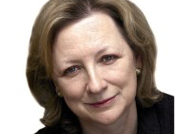Carla Carlisle on art and symbolism
Carla visits the workshop of artist Craigie Aitchison, and ends up buying something rather unexpected


The beginning of Holy Week began for me one day last summer when I made my way to Borough High Street in search of St George the Martyr Church. I was looking for a workshop behind the church where the artist Craigie Aitchison makes his screen prints. I’ve long loved his work, but all I’ve ever owned is a mouse mat from the Royal Academy shop. In August, I decided to go further. The picture I had in mind was the size of a postcard called Lamb in a Green Field.
Sister Wendy believes that some artists seem to use images that speak of the mystery of God. She thinks that Mr Aitchison is one of those artists. Under her influence, I saw my Aitchison lamb as a kind of Agnus Dei, but when I found the Advanced Graphics workshop and studied the picture, I did not see a lamb that was the symbol of Jesus Christ in his role of the perfect sacrificial offering that atones for the sins of humanity. I saw a white lamb in a green field against a blue sky.
I don’t think the artist would be troubled by my failure to see the religious imagery. Mr Aitchison is one of the few contemporary artists to paint convincing Christian pictures, but he leaves ecclesiastical interpretation to others. In any case, my decision not to buy the lamb wasn’t theological. I simply saw another picture by the artist. One of Christ on the cross.
Crucifixion paintings are an important theme in Mr Aitchison’s work. The cross is always in a landscape, isolated and alone. Often, the cross is in front of Holy Island by the slope on Arran where the ashes of the artist’s parents are scattered. Occasionally, there is a lamb nearby, but in the artist’s Crucifixion that hangs in King’s College Chapel, there is only the solitary figure of Christ.
The picture I chose shows Christ on the cross against a dark sky, with a dog (his Bedlington terrier) at the foot, gazing upwards, one paw lifted. Perched on one arm of the cross are two birds. Above the head of Christ is a white dove. It was an impetuous purchase. I set out to buy a picture the size of a dollar bill, and I bought a picture the size of a duvet. The only wall large enough for it was on the stairs, where a 17th-century tapestry hangs. The picture now hangs over the tapestry.
But size was a minor problem compared to the subject. Unless it’s 300 years old and you inherited it, a picture of Christ on the cross hanging in your house makes folks nervous. Reactions to the Aitchison Crucifixion are either ‘Nice, but I wouldn’t want to live with it’, or sheer Dawkinsian disbelief that I could display such lack of taste and intelligence, responses that make me babble about the artist’s secular credentials born in Scotland, son of a Law Lord who became Lord Provost of Edinburgh, studied at the Slade, Royal Academician who resigned over the Saatchi ‘Sensation’ show. I suggest that the painting captures human suffering, the grey dog with his uplifted foot speaks of grief, the white dove symbolises hope. I sound like an English country vicar whose mission is to make the non-religious feel comfortable.
Even Sister Wendy confesses to scurrying past Ruben’s The Descent from the Cross, Titian’s Pietà, Grünewald’s Crucifixion. She finds them too painful. But if we scurry past the Crucifixion, we risk bypassing the Resurrection. Easter is the mainstay of the religious year, the force that keeps the Christian faith from falling into the void. It would have been easier to bring Mr Aitchison’s Lamb home. It would sit on a mantlepiece and embarrass no one. I think of that lamb each day as I check on my living lambs, counting them, praising the good mothers. They delight the visitors who exclaim ‘Easter lambs’. Agnus Dei indeed.
Exquisite houses, the beauty of Nature, and how to get the most from your life, straight to your inbox.
Country Life is unlike any other magazine: the only glossy weekly on the newsstand and the only magazine that has been guest-edited by His Majesty The King not once, but twice. It is a celebration of modern rural life and all its diverse joys and pleasures — that was first published in Queen Victoria's Diamond Jubilee year. Our eclectic mixture of witty and informative content — from the most up-to-date property news and commentary and a coveted glimpse inside some of the UK's best houses and gardens, to gardening, the arts and interior design, written by experts in their field — still cannot be found in print or online, anywhere else.
